
Migrating from Microsoft Azure to Google Cloud Platform (GCP) can be a strategic move for many organizations seeking better pricing, performance optimization, or alignment with other business units already on GCP. However, one of the key challenges during this migration is understanding how to effectively map Azure services to their GCP equivalents. This process is crucial for ensuring continuity, minimizing downtime, and optimizing workloads on the new platform.
In this blog, we’ll explore the most effective ways to map Azure services to their GCP counterparts and highlight essential tools and tips to streamline your cloud migration services.
Why Mapping Matters in Cloud Migration
Every cloud provider offers a broad spectrum of services—compute, storage, networking, analytics, AI, and more—but these services differ in capabilities, naming conventions, configurations, and billing models. Mapping services correctly ensures:
- Functional parity in the new environment.
- Optimized resource allocation and cost efficiency.
- Reduced downtime during migration.
- Easier troubleshooting and support.
Now let’s look at how you can map the key Azure services to their GCP equivalents.
1. Compute Services
Azure Virtual Machines (VMs) → Google Compute Engine (GCE)
Both platforms offer virtual machines with various operating systems, sizes, and configurations. GCE offers similar machine families (E2, N2, C2) to Azure’s VM series (D, E, F, etc.).
Azure App Services → Google App Engine
If you’re using Azure App Services for web app hosting, GCP’s App Engine offers a similarly managed PaaS environment for deploying and scaling web apps.
Azure Functions → Google Cloud Functions
For serverless computing, GCP’s Cloud Functions closely mirrors Azure Functions in terms of execution model and use cases.
2. Storage Services
Azure Blob Storage → Google Cloud Storage (GCS)
Both services provide scalable object storage with lifecycle rules, access management, and tiered storage options.
Azure Files → Filestore / Cloud Storage (depending on use case)
Azure Files, which provides managed file shares, can be replaced with GCP’s Filestore for high-performance NFS storage or GCS for object-based access.
Azure Disk Storage → Persistent Disks in GCE
Managed disk options in Azure map to Persistent Disks in GCP for use with Compute Engine VMs.
3. Database Services
Azure SQL Database → Cloud SQL (MySQL/PostgreSQL/SQL Server)
Cloud SQL supports all major databases and provides a similar managed experience for relational data.
Azure Cosmos DB → Firestore / Bigtable
Depending on your use case (document vs wide-column database), Firestore is better suited for serverless apps while Bigtable is ideal for large-scale workloads.
Azure Database for PostgreSQL/MySQL → Cloud SQL for PostgreSQL/MySQL
Both provide managed database services, with similar features like backups, high availability, and read replicas.
4. Networking Services
Azure Virtual Network (VNet) → Google Virtual Private Cloud (VPC)
GCP’s VPC offers global networking, similar to Azure VNets, allowing flexible resource allocation and firewall control.
Azure Load Balancer → Google Cloud Load Balancing
Both services support external/internal load balancing, autoscaling, and global distribution.
Azure VPN Gateway → Cloud VPN
To securely connect on-premises networks, GCP’s Cloud VPN can replace Azure’s VPN Gateway.
5. Identity and Access Management (IAM)
Azure Active Directory (AD) → Google Cloud Identity / Identity Platform
While Azure AD is more tightly integrated into Microsoft environments, GCP offers similar identity management capabilities through Cloud Identity and can integrate with Azure AD or other identity providers using SAML/OIDC.
Role-Based Access Control (RBAC) in Azure has a direct mapping in GCP through IAM policies, enabling granular control over resources.
6. Monitoring and Logging
Azure Monitor / Application Insights → Cloud Monitoring / Cloud Logging (formerly Stackdriver)
These services allow you to collect, monitor, and analyze metrics and logs from applications and infrastructure, ensuring visibility and observability post-migration.
7. AI and Machine Learning Services
Azure Cognitive Services → Google Cloud AI APIs (Vision, Speech, Translate, etc.)
GCP provides a rich set of pre-trained AI models and APIs, equivalent to Azure’s cognitive offerings.
Azure Machine Learning → Vertex AI
For building, training, and deploying ML models, GCP’s Vertex AI offers an integrated platform similar to Azure ML.
Tools and Best Practices for Effective Mapping
- Use Mapping Guides and Comparison Tables
Google provides Azure-to-GCP service mapping guides that offer side-by-side comparisons of service features and limitations. - Perform a Detailed Inventory Audit
Catalog all the Azure services currently in use, including configurations, dependencies, and service tiers. This helps identify the correct GCP equivalents and avoid misconfigurations. - Leverage Automation and Assessment Tools
Use tools like StratoZone, Migrate for Compute Engine, or third-party assessment tools to evaluate workloads and generate compatibility reports. - Test Before You Migrate
Start with a pilot migration. Test the mapped services for performance, cost, and functionality in GCP before scaling to the full environment. - Partner with Cloud Migration Experts
For complex migrations, it’s wise to work with professionals who specialize in cloud migration services. Their experience can help you avoid costly errors and ensure a smooth transition.
Common Pitfalls to Avoid
- Assuming service parity: Even if services appear similar, subtle differences in SLAs, configurations, or scaling behavior can affect performance.
- Overlooking cost structures: Pricing models vary between Azure and GCP. Analyze the total cost of ownership (TCO) before finalizing mappings.
- Ignoring compliance needs: Ensure that the GCP region and services you choose meet your compliance requirements.
- Neglecting dependencies: Migrating one service may impact others. Always assess upstream and downstream integrations.
Final Thoughts
Successfully migrating from Azure to GCP requires more than just moving data—it requires careful planning and service alignment. By understanding how to effectively map Azure services to GCP equivalents, organizations can unlock the full potential of GCP while maintaining operational continuity. Whether you’re looking to optimize performance, cut costs, or align with strategic goals, effective mapping is a critical first step.
Need expert support for your Azure-to-GCP migration? Partner with Exinent’s Cloud Migration Services team and ensure a smooth, secure, and successful transition.
